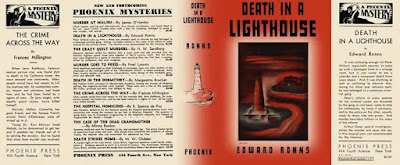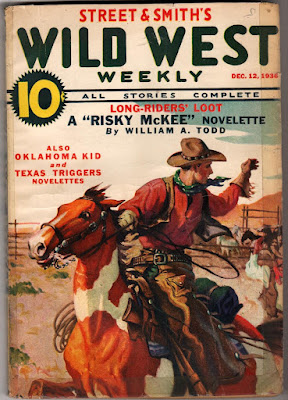This is a pretty obscure Western pulp. I don't know how many issues there were, since only one has been indexed on the Fictionmags Index. This is Volume 1, Number 5. Nor do I know who painted the cover. But the group of authors inside is a decent one: Ed Earl Repp, J.E. Grinstead, Hapsburg Liebe, Carmony Gove, and Clem Yore. Those hombres generally knew what they were writing about.
UPDATE:
On Facebook, John Locke provided some information from the magazine AUTHORS
& JOURNALISTS about GUN-SWIFT WESTERN and its editor/publisher (?) Z.S.
Sklar. From the October 1939 issue:
Who Is
Z.S. Sklar?
Col.
John J. Boniface, who writes under the pseudonym of Wilton West and various
others for the adventure magazines, sends us a heavy sheaf of correspondence
which he defines as a serial entitled, "The Mystery of Z.S. Sklar."
The
opening installments of this engrossing serial relate to the call of a magazine
entitled Gun-Swift Western, of 19 Avon Place, Springfield, Mass., for manuscripts.
The call brought a manuscript last spring from Col. Boniface under one of his
pennames, Gordon Strong. Not hearing from the manuscript, the author wrote several
letters of inquiry, which were never answered, although the letters were not
returned. The Railway Express Agency, in whose hands the matter then was placed,
had no better luck, reporting: “Unable to contact the party.”
THE
AUTHOR & JOURNALIST, writing in behalf of the author, had a little better
luck. In response to its inquiry, came a brief typewritten note: “Magazine has
been discontinued.--Z.S. Sklar.”
Acting
on this information, the author put the matter into the hands of the post
office department. Though declining to take action, the inspector at Boston,
Mass., informed him that other writers had complained, and reported that their
manuscripts were later returned by the Double-Action Publishing Co., of New
York. But Cliff Campbell of the D-A group reported when queried that he had no
record of the yarn.
Final
appeal was made to the police department of Springfield--and here the mystery
not merely persisted, but deepened. Quoting from the letter of John L. Maloney,
chief of police:
“While
I have caused a thorough investigation to be made, I am unable to locate Z.S
Sklar or the Gun-Swift Western magazine at 19 Avon Place, this city. Inquiries were
made of the janitor of the above-mentioned address, which is an apartment block
in the residential section, who informed our investigating officer that Sklar
or this magazine company which you mention has never been located at that
address. Inquiries were also made of the letter carrier who delivers mail in
this district, who states that he has never delivered mail to Sklar at 19 Avon Place.
He is not receiving mail at our local post office. His name does not appear in
our city or telephone directory.”
Evidently
it all never happened--but others who are in like position must join the author
in wondering how come that the magazine did receive manuscripts at that
address, return some, and contrive that others were returned through the
Double-Action group. We hate to see a masterly and persistent job of sleuthing
for a lost manuscript, such as that conducted by Col. Boniface, end up in a
blind trail.
From
the November 1939 AUTHOR & JOURNALIST:
Responding
to the editorial in our last issue, relating to the mystery of Gunswift Western
and Z.S. Sklar, Louis H. Silberkleit, president of Winford Publications, Inc.,
writes: “Gunswift Western was not connected in any way with the Double Action
Group. It so happens that when the magazine was discontinued, the editor, who
certainly did run his business from 19 Avon Place, Springfield, Mass.,
approached us for a job, and was hired. He asked if we would permit him to have
his mail forwarded from Springfield to this office. We said yes. That's all we
know about the situation.”
I'm
always fascinated by stuff like this, and many thanks to John Locke for
providing it.




































